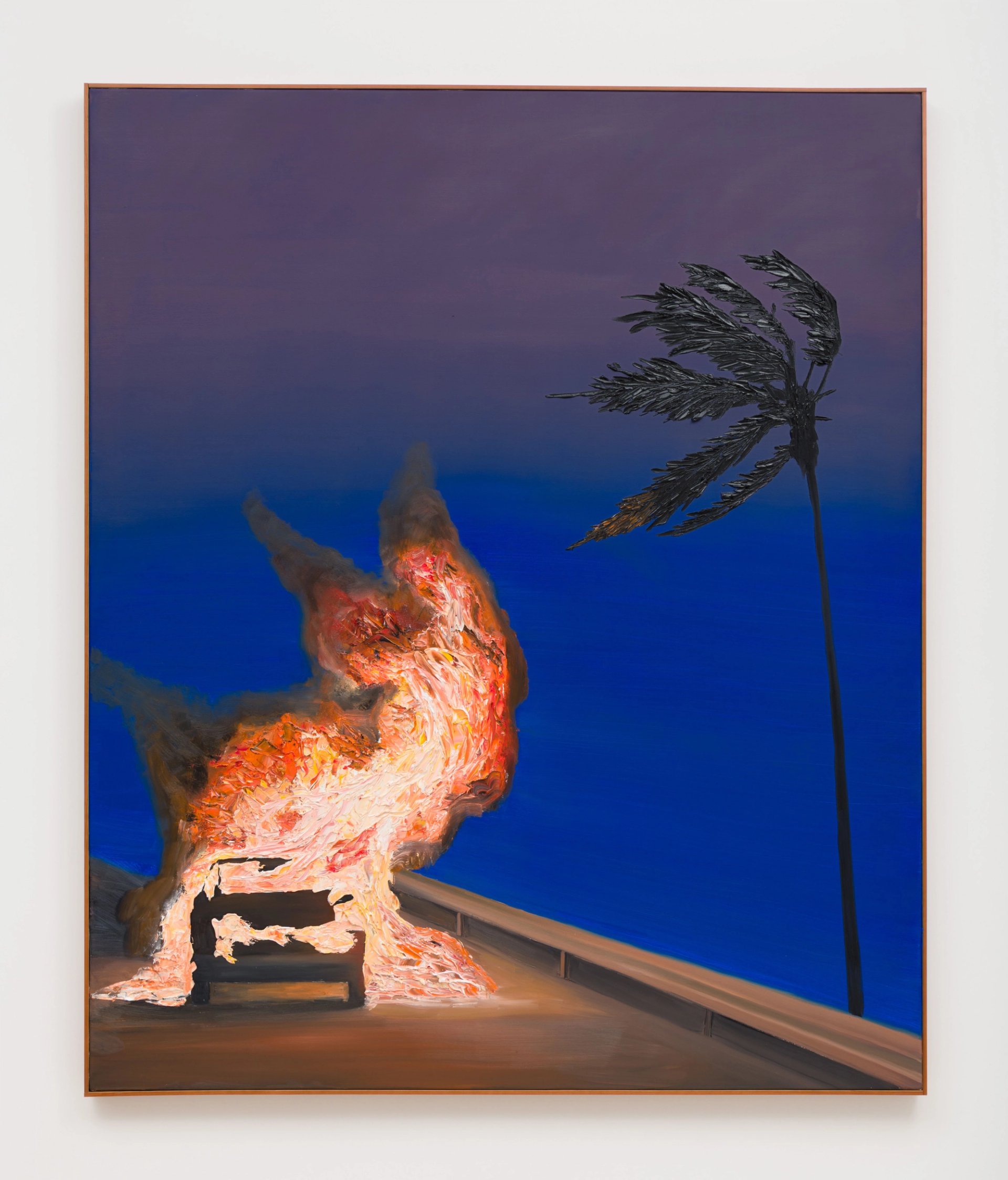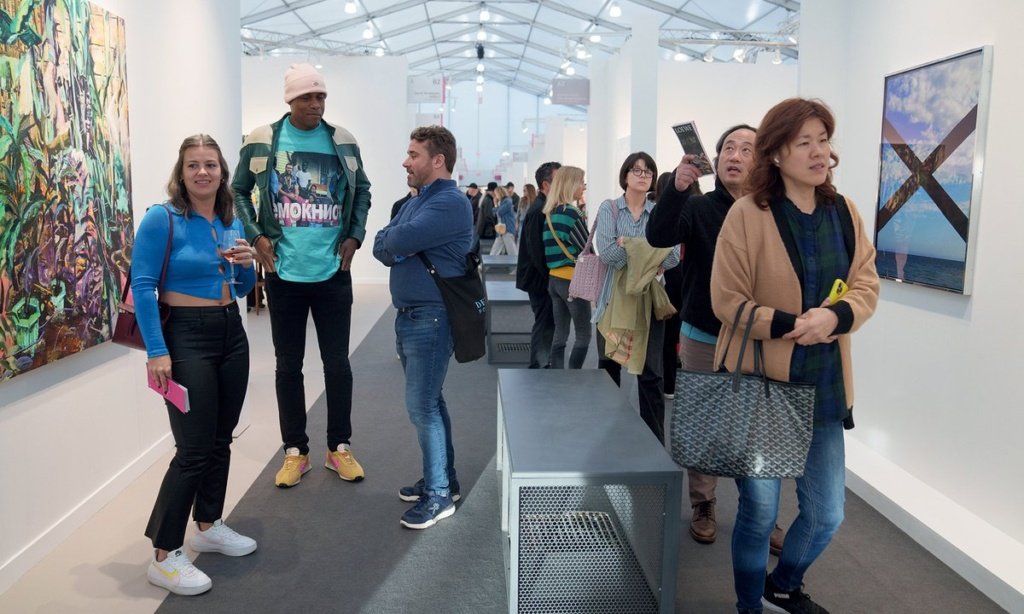Less than two months after some of the most destructive wildfires in US history, Frieze Los Angeles and its satellite fairs have brought the art world’s focus onto the city at a time when most local galleries and institutions agree that their support—and cash—is most needed.
“The energy yesterday was astounding,” Christine Messineo, Frieze’s US fair director, said on Friday. “Our community, our art world, showed up for the fair in a major way. Not only were they participating and present, they were purchasing. We know that Los Angeles galleries were very much ready for the economic impact of purchases at this moment.”
Local dealers at Frieze, Post-Fair and the Felix Art Fair were largely upbeat, saying they were hopeful about sales and that the community was banding together in support after the fires. While their optimism was contagious, the fires did seem to hang over the week; one local dealer pointed out that from the tower rooms of the Hollywood Roosevelt hotel, which hosts Felix, burned vegetation could be seen in the surrounding hills.

Alec Egan’s Guard Rail (2025), on show at Anat Ebgi’s gallery at Frieze; Egan created the painting after losing numerous works in the fires Courtesy the artist and Anat Ebgi, Los Angeles/New York. Photograph by Mason Kuehler
Some out-of-towners were more blunt, including a dealer at Felix who said: “You really feel the effect of the fire.” The lines leading up to the tower rooms, which can run through the length of the hotel lobby, were noticeably shorter, and several attendees remarked being surprised how much less crowded the pool seating was during the VIP preview on Thursday afternoon.
While the fair seemed quieter, there was some debate as to whether the demure mood was due to uneasiness after the fires or the overall downturn in the art market at large. “There’s a general consensus that things are slowed down,” Mills Morán, a co-founder of Felix and gallerist at Morán Morán, says. “The mentality is, the stampede years are kind of over. People are having a more thoughtful approach to work, life, health and also collecting art. It doesn’t have to go as fast or bigger.”
The show must go on
When the organisers of the Spring Break Art Show announced the cancellation of their Los Angeles fair this year, they cited both market saturation and apprehension about hosting a fair so soon after a natural disaster, along with concerns over water and air safety. Locally, most art workers toe the party line in support of the fairs moving forward.
“There was a universal consensus that the show must go on, but not at all costs,” Morán says; Felix was the first Los Angeles fair to announce it would take place as usual. “I would be the first one to say not to do it if it was a bad idea, but I had a really good intuition that six weeks out we would have enough space between the disasters, the fires, to really do something positive.”
Dealers and advisers in Los Angeles say they understand worries about carrying on with the art fairs in the light of the mass destruction, displacement and death caused by the wildfires. However, the majority expressed concerns that cancellation would have done more harm than good for the local art community.
“I’m fully in the camp of proceeding. It was important that this is not a time to shy away from when the city was in total devastation and tragedy,” says the Los Angeles-based art adviser Victoria Burns. As for whether her clients were ready to spend money, she adds: “I’ve got everybody buying.”
Others were more sceptical: Peter Goulds, the founder of the Venice Beach gallery L.A. Louver—celebrating its 50th anniversary this year (see p2)—says that while moving forward was not a bad decision, “it’s not necessarily the right thing either”. He says he would have liked to see the fair postponed and a large donation made to wildfire relief instead.
Changing art ecosystem
In the 50 years since he began selling art in Los Angeles, Goulds has staged more than 660 exhibitions and seen other galleries come and go through multiple art market boom and bust cycles.
“The art scene in LA is always changing, as it probably is everywhere. There’s a new cycle of energy that’s come into the city since the pandemic,” Goulds says. “A lot of galleries internationally think the grass is greener on the other side, so they’re starting to come over as they’ve done before at different times. Clearly, there’s an audience here they have been servicing.”
Burns says some of the pandemic-era art boom led to overconfidence in the Los Angeles market. After a slow 2024, she says, many dealers have reigned in their spending. “That slow year last year forced some people to recalibrate their expansions,” she says. “The galleries that had four locations might have dropped back down to three or two. I think a little of that is natural to the market.”
Much excitement this week surrounded the launch of Post-Fair (see p2), held at the former Santa Monica Post Office, an Art Deco structure built during the New Deal era. The 26 exhibitors of the pilot edition are showing work without stand structures, giving the light-filled space more of an exhibition feel than a typical white-tent fair. The Los Angeles dealer and fair founder Chris Sharp acknowledges that the slow market and traumatic wildfires did not exactly create the best circumstances for a new fair, but the event’s relatively low exhibitor fees for galleries ($6,000) and more intimate setting “feels like it’s suited to the moment”, he says.
“Beyond LA, it’s part of a general sea change. A lot of people are fed up with the status quo,” Sharp says. “Younger dealers feel a need to seize the means of production, to use classical Marxist terminology. That’s more of what we’re responding to in general.”
Lower stand fees allow exhibitors to take risks on showing emerging artists to new audiences, Sharp says. He adds that it is too soon to tell if there will be a second edition of Post-Fair, but says the feedback has been enthusiastic.
Aside from the fairs and commercial gallery shows, scrappy pop-ups are appearing all over Los Angeles during Frieze. A group exhibition put on by local artists was retitled Redacted Lincoln Heights DTLA at the last minute after the original name, Art Basel Lincoln Heights, reportedly earned organisers a cease-and-desist notice from the real Art Basel organisation. The confusing name, a long list of parody sponsors and “the fact that it barely even made sense” has delighted the art community, the artist and co-organiser Wyatt Mills tells The Art Newspaper. The show includes work by local artists including Zoe Alameda, Isis Cahuas and Anna Lauree.
Visiting from New York is Uhaul Gallery, a travelling art space staged in the back of a moving truck. Jack Chase and James Sundquist, the duo behind the gallery, have teamed up with Slamdance Film Festival to stage Uhaul Gallery’s first exhibition outside of New York. The show Drive-In is made up of work by artists from and living in Los Angeles. Before the show’s opening on Saturday, Chase and Sundquist drove the roving gallery to the Frieze and Felix fairs. After they were asked to leave both, the duo found a warm welcome at Post-Fair. (“The official view of the gallery is that Frieze hates freedom and Felix is not as cool as they think they are,” Chase said.)
Many dealers participating in the week’s fairs feel it is still too soon to tell what larger impact the fires will have on Los Angeles as a whole, much less the city’s art scene. A study from the Anderson School of Management at the University of California, Los Angeles released last month estimated that the wildfires have cost the city between $95bn and $164bn in total property and capital losses.
Goulds credits his 50-year career in Los Angeles art to the strength of L.A. Louver’s programming and gallery shows. The gallery has never relied too much on fairs to support the business, he says, and instead focuses on nurturing relationships with collectors year-round. Amid the market downturn of the past two years and the aftermath of last month’s wildfires, he says, “If artists are relying on the fair to help save them, they’re going to be disappointed.”
One Los Angeles-based dealer with a uniquely many-angled view of fair week is Helen Babst, a co-partner at Babst Gallery, which has stands at three fairs: at Felix, in the Focus section of Frieze and a corner spot at Post-Fair.
“I had no idea what the post-fire landscape was going to be, and even if it would be considered in good taste to buy work,” Babst says. “But people are really understanding that we have to support the creative classes, and they’re more at risk now than ever.”
She says sales have been good throughout the week, and is especially happy about the number of museum representatives visiting the fairs and collectors who travelled in from other cities. “It’s rare to not feel cynical about the art world,” Babst says. “But my heart feels warm.”

